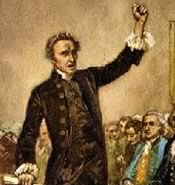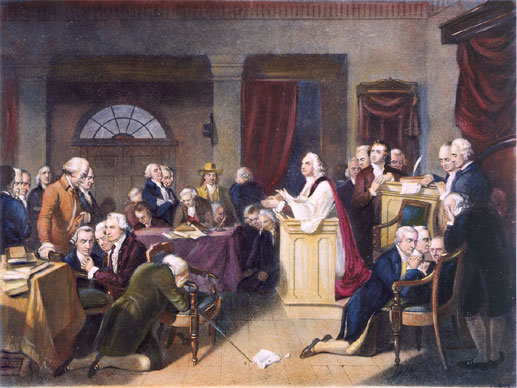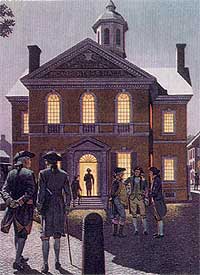
The Declaration of Independence
Lesson Plan
The First Continental Congress
- What was the primary reason why the colonists decided to send their leaders to Philadelphia in September and October of 1774?
- What were some of the ideas and proposals discussed?
- Ultimately, what did the Congress decide to do?

What do you do if you fail as a storekeeper and farmer? Become a lawyer! That's what Patrick Henry did. By the time he became a member of the First Continental Congress, Henry was known as a great orator.
After Parliament passed the Intolerable Acts, the patriot cause got much stronger. The belief that the colonies should be independent was becoming very popular. The Committees of Correspondence were publishing volumes of material in support of American independence.
Since support for independence was growing, colonial leaders agreed that they should have another intercolonial meeting. It had been almost ten years since the Stamp Act Congress. In September of 1774, the First Continental Congress was held in Philadelphia.
This time, participation was better. Georgia was the only colony that did not send a delegate. The delegates who were there had been selected, not elected. The election of such representatives was illegal. Fortunately, those who attended seemed like natural leaders. They included: Sam and John Adams from Massachusetts, John Dickinson from Pennsylvania, and Richard Henry Lee, George Washington, and Patrick Henry from Virginia. It took seven weeks for the group to agree on a course of action.

The first action they decided on was nonimportation. Colonies would make every effort not to purchase goods from the British. To make sure of this, the Congress set up an organization called the Association to police trade activity.
A declaration of colonial rights was also drafted and sent to London. This took a while. Most of the debate during this meeting revolved around defining the colonies' relationship with mother England. Joseph Galloway of Pennsylvania proposed an imperial union with Britain. Under this program, all acts of Parliament would have to be approved by an American assembly to take effect. If they had tried it, this type of change might have delayed the Revolution. But, the delegations voted against it — by one vote.
Suppose you were a delegate at the convention, come up with two questions you might ask Joseph Galloway about his proposal to help you decide which way you want to vote.
The Congress also agreed to meet again in May 1775 if their issues were not resolved. This was a major step in creating a decision-making group to regularly represent the colonies. It was the first time this happened in colonial history.
When Parliament chose to ignore the written statement from the Congress, they still met that next May. But by this time things had gotten much worse. The Second Continental Congress was faced with dire choices. It was too late to avoid a war. Just the previous month, the first blood of the Revolution was spilled at the battles of Lexington and Concord.

Carpenters' Hall — the meeting place of the First Continental Congress
At these two meetings, at Carpenter Hall in Philadelphia, America came together politically for the first time on a national level and the first seeds of democracy were sown.
Find a link on the First Continental Congress, Review it and rate it.
- What was the primary reason why the colonists decided to send their leaders to Philadelphia in September and October of 1774?
- What were some of the ideas and proposals discussed?
- Ultimately, what did the Congress decide to do?
Start page | The Document | A Reading | Signers | Related Information | Jefferson's Account | Declaration House | Declaration Timeline | Rev. War Timeline | More Resources | Lesson Plan |




